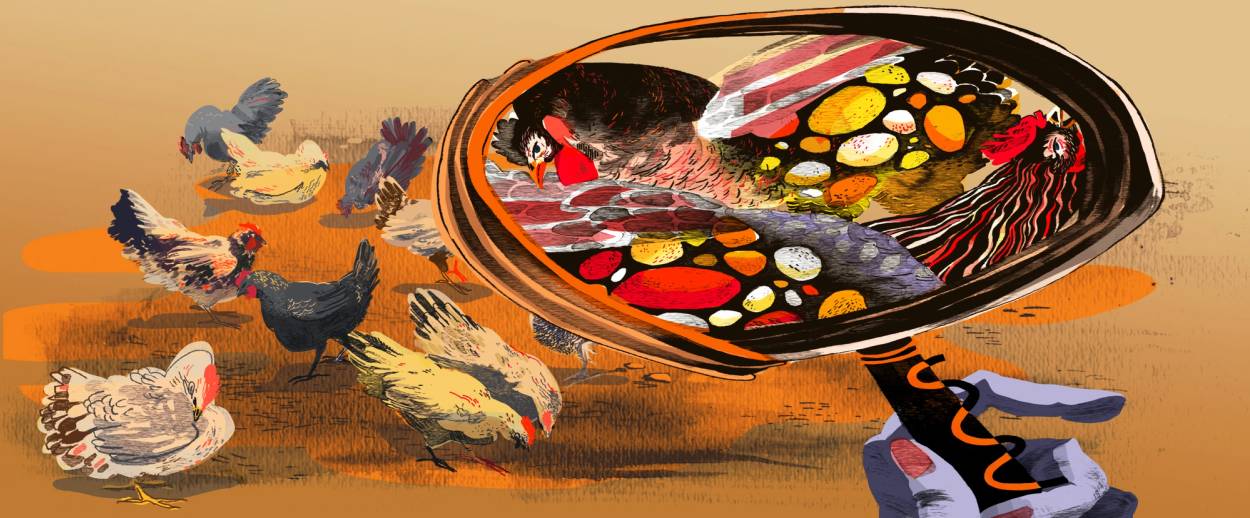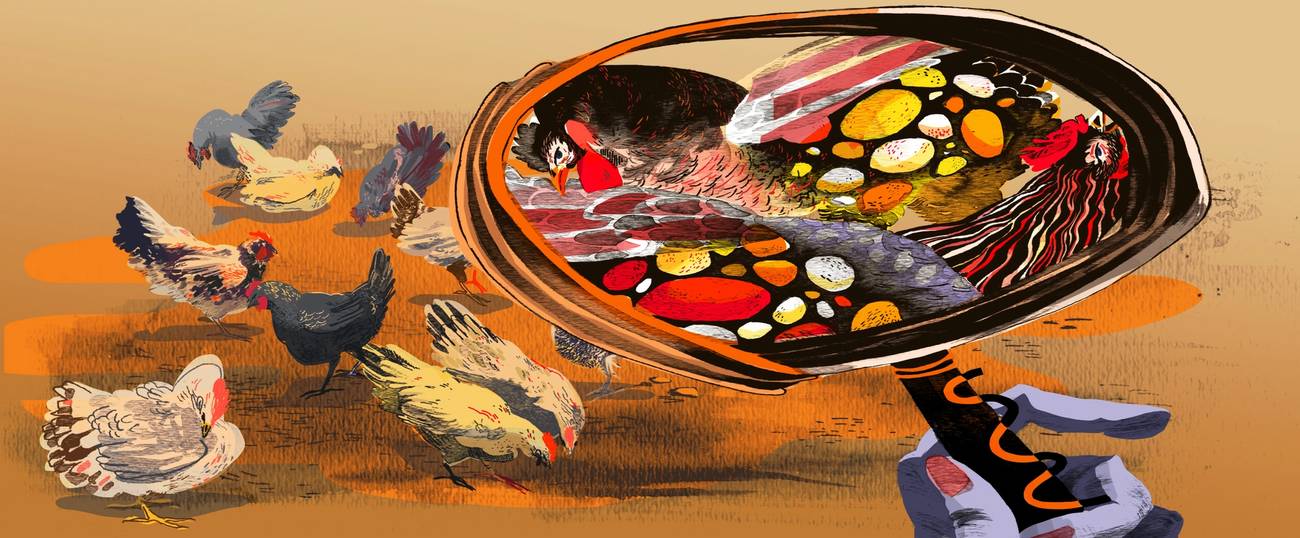Searching for the Golden Egg
Eyerlekh—unlaid eggs found inside slaughtered hens—were a Jewish delicacy. Now they’re hard to find. So I went on an egg hunt.




I have never been much interested in food conquests. Standing in an hours-long line to taste the newest doughnut or taco? I can’t be bothered. Collecting snapshots of dishes on my Instagram feed like badges on a Girls Scout sash? Not interested. But a few weeks back, I found myself stuck in heavy traffic and growing increasingly stressed and fidgety, as I made my way out of New York City to get my hands on a delicacy I’d been itching to sample: eggs.
Not just any eggs, mind you. Eyerlekh.
Translated from Yiddish as “little eggs,” eyerlekh are the not-fully-developed eggs found inside just-slaughtered laying hens—chicken caviar, essentially. My mother, who grew up eating them poached in Friday night chicken soup, raved to me about their sweet and delicate flavor, their texture like silken tofu. “They were like nothing else,” she told me.
Learning about eyerlekh felt both exhilarating and a little disheartening—like listening to one half of a record for years only to discover you could flip it over to the B-side. After a lifetime of eating eggs fried, hardboiled, scrambled, and over easy, I had never considered they might be edible—let alone delightful—in another form. Nor did I realize they had once played such an important role in Jewish cuisine. As a food writer who spends most of my working hours thinking about Jewish food history and culture, I had to try them.
Unfortunately, tracking down eyerlekh proved complicated. Back when Jewish housewives like my grandmother purchased whole chickens from the kosher butcher, these “golden treasures,” as my mom called them, were a fairly common find. “Our housekeeper, who had grown up in the South killing chickens, would usually find at least one or two inside as she cleaned them,” my mom said. Today, thanks to the rise of pre-packaged chicken parts and stringent health code laws, they are all but impossible to source.
So several weeks ago, I sent an email to Blue Hill at Stone Barns, the James Beard award-winning restaurant and agricultural center about an hour north of my Brooklyn apartment. I had read that their executive chef, Dan Barber, used immature eggs from Stone Barns’ laying hens in some of his dishes and wondered if they might spare a couple from his stock. To my good fortune, they happened to have a hen slaughter scheduled. (Stone Barns slaughters about 250 birds—broiler chickens, turkeys, poussin, and geese—each week to supply Blue Hills’ kitchens, but they dedicate only a few weeks each spring to the laying hens.) If I was willing to make the drive, they would pack a few on ice for me to take home. I was willing.
***
Eyerlekh, which are primarily known in English as immature or unborn chicken eggs, technically refer to eggs found anywhere along a chicken’s reproductive system before being laid. Some already have fully formed shells and would likely have been laid the same day the hen was slaughtered. Others have thin, pliable, semi-formed shells like wet parchment paper encasing the yolk and a tight mass of white. But true eyerlekh, like the ones my mother ate, are shell-less and white-less yolks. Varying in size from a pinhead to a small apricot, they are bright orange with a thin, threadlike membrane that can be peeled off once the egg is cooked.
These yolks are a delicacy in parts of traditional Asian and Latin American cuisine and in many cultures where a “waste not, want not” ethos prevails. Jewish cooks traditionally simmered the slaughtered hen into soup for Sabbath dinner, and then poached the captured eggs in the broth in a move at once elegant and economical. In a slightly puzzling piece of Jewish law logic, laid eggs are considered pareve, which means they can be served with either dairy or meat at a kosher meal. Eyerlekh, however, are still part of the chicken, and therefore categorically defined as meat, making them the perfect proteinous soup dumpling.
Like the gorgle (chicken neck) and chicken feet, which bubbes of a certain generation are known to adore, they were considered something different, something special. “Sometimes you would get two or four of them, and sometimes none at all. You always hoped they would be there,” said food writer and cookbook author Mimi Sheraton, who grew up eating them in Brooklyn. “My mother would try to divide the eggs evenly between me and my brother, like a prize.” Similarly, my own mom remembers her grandmother painstakingly dividing any unborn eggs among 13 grandchildren.
It seems a shame that such a beloved treat could have so thoroughly disappeared. As a young woman in the 1970s, my mother used to occasionally buy containers of frozen eyerlekh in the kosher section at a specialty food market in Chicago. “When I first found them, I went out of my mind a little,” she said. Before calling Stone Barns, I tried to find eyerlekh at supermarkets and several small-scale local butchers, with no luck. “By the time the chickens get to us, they have been eviscerated and cleaned, the USDA makes sure of that,” said Benny Pizzuco at the 79-year-old Florence Meat Market in the West Village. According to official guidelines, “ova” (as the USDA’s Food and Safety Inspection Service calls them) can technically be retailed, but only if they are pasteurized—a step that would almost certainly destroy the vulnerable yolks.
Next I emailed my friend Naftali Hanau, who runs the kosher sustainable meat company Grow & Behold, to see if he might be a source. “Unfortunately, they really are ‘lost’ because nobody really schects [slaughters] laying hens anymore,” he said. Fair enough. By the time a laying hen moves past its prime egg production years, its meat tends to be tough and stringy—fit for little else besides soup, and not particularly profitable.
Contacting New York City’s network of farmers markets, where farmers have been known to occasionally sell hens, was similarly fruitless. Perhaps most disappointing, however, was Sammy’s Roumanian Steak House. The 40-year-old restaurant is known for celebrating Jewish culinary throwbacks like stuffed cabbage, schmaltz, and, yes, eyerlekh. “Equally good are the broiled chicken livers with baked unborn eggs,” wrote Sheraton in her 1982 New York Times review of the restaurant.
According to Sammy’s menu—both online and at the restaurant—eyerlekh are still available. But it turns out they have not been served for a decade or more. The problem is the same there as everywhere: sourcing. As a waiter I spoke to over the phone told me, “After the bird flu scare, they all disappeared and we couldn’t get them anymore.”

Meanwhile, about eight years ago, Barber and his team of chefs at Blue Hill began experimenting with unborn eggs—a perk of partnering with an agricultural center that keeps a flock of 1,200 free-range laying hens. Today they use some of the freshly harvested yolks for pasta and poaching, but the majority are cured with salt and sugar and hung to dry in cheesecloth. The preserved yolks are then shaved over dishes as a garnish.
As I neared Stone Barns, my palms began to sweat a little. I have only watched birds get slaughtered and eviscerated a handful of times and would be lying to pretend I don’t still get squeamish. But I donned a blue plastic apron and leaned in anyway as livestock director Craig Haney removed globe after slippery, tangerine-colored globe, along with a few fully shelled eggs, from the hens, depositing them in a small metal basket.
On the drive back to Brooklyn, I kept one hand placed protectively over the plastic quart container filled with eyerlekh jiggling in an ice water bath. I thought about my grandmother singeing the excess feathers off the chickens she brought home from the butcher, and their housekeeper, Katie, following the same steps I watched Haney do.
Back at my apartment, I took to my downstairs neighbor’s place the quart container and a pot of chicken soup I had made. (The eyerlekh were not technically kosher, because they came from birds not slaughtered according to kosher law, so I could not do the final poaching in my own kitchen.) A few minutes of simmering later, we sat down to an impromptu Sunday-night take on Shabbat dinner. We each had two eyerlekh in our bowls, which felt like true luxury.
Spooning, at last, into the tender yolks, they tasted clean, mellow, and creamy—a rich complement to the savory broth. Flavor-wise, they were not worlds different from a good quality egg yolk, perhaps, but they certainly had a better story. And ultimately, the most crave-worthy, nostalgia-inducing foods are as much about the story as anything else. I wished I could overnight a bowl to my mom.
***
Like this article? Sign up for our Daily Digest to get Tablet Magazine’s new content in your inbox each morning.